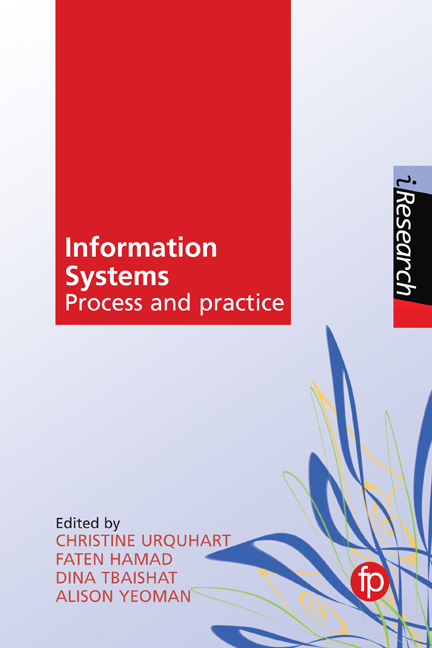Book contents
- Frontmatter
- Contents
- List of tables and figures
- Series editor's foreword
- About the authors
- 1 Introduction
- 2 Approaches to information architecture
- 3 Taxonomy testing for information architecture
- 4 The enterprise website and its information structures
- 5 Analysing activities, roles and processes
- 6 Libraries and the organisation of library processes – a history of operational research, and the use of process modelling
- 7 Using Riva process modelling to study book acquisition in academic libraries
- 8 Workflow analysis and process mapping in US academic libraries
- 9 A theoretical framework for designing and evaluating semi-structured document triage interfaces
- 10 Resource discovery case studies
- 11 Increasing social connection through a community-of-practice-inspired design
- 12 Methods for studying information provision, networking and communication in patient support groups
- 13 Health information systems: clinical data capture and document architecture
- 14 Producing systematic reviews and getting evidence to the clinician
- Index
2 - Approaches to information architecture
Published online by Cambridge University Press: 08 June 2018
- Frontmatter
- Contents
- List of tables and figures
- Series editor's foreword
- About the authors
- 1 Introduction
- 2 Approaches to information architecture
- 3 Taxonomy testing for information architecture
- 4 The enterprise website and its information structures
- 5 Analysing activities, roles and processes
- 6 Libraries and the organisation of library processes – a history of operational research, and the use of process modelling
- 7 Using Riva process modelling to study book acquisition in academic libraries
- 8 Workflow analysis and process mapping in US academic libraries
- 9 A theoretical framework for designing and evaluating semi-structured document triage interfaces
- 10 Resource discovery case studies
- 11 Increasing social connection through a community-of-practice-inspired design
- 12 Methods for studying information provision, networking and communication in patient support groups
- 13 Health information systems: clinical data capture and document architecture
- 14 Producing systematic reviews and getting evidence to the clinician
- Index
Summary
COMMENTARY: CHRISTINE URQUHART
Chapter 2 introduces the main concerns of information architecture, the design and organisation of websites to support finding, sharing and understanding information across many channels. I was interested in reading the first sections of Chapter 2 on the use of the words ecology and ecosystems by some prominent information architects (Rosenfeld, Morville and Arango, 2015) to describe what information architecture is about. In biological terms ecology means the pattern of relations between organisms and their environment. Such relations are often complex and intricate. We can speculate that the choice of the terms ecosystems and ecology was intended to convey the message that we need to balance many factors in information architecture – the aesthetic design, the feel of the site, the functions supported, the organisation of information and knowledge, and the need to work across different ecosystems or media. An information architecture may be successful as it has happened to find a pattern of relations that works for most users, across their smartphones and their laptops. Other information architects have examined similar themes but have used the word context (Hinton, 2009). Hinton argues that the word context really means the mental map that we have layered on top of our sensory experience, and that information architecture concerns the design of contextual experience using hyperlinks. The web gives new ways of shaping our contextual experience. Get it right and we can share information and knowledge with many more like-minded people, although there may be downsides to the personalisation bubbles that can be created. But, worse for the individual is the possible widespread publication on the web of embarrassing information that was assumed to be forgotten. Those hyperlinks have changed our contextual experience in ways that we are still trying to accommodate.
Hinton (2015) develops the meaning of contextual experience for information architecture further. It would be convenient to assume that we could all define a goal for our information searching at the outset, or that a particular type of goal would require a particular set of information-seeking activities or information behaviour. But often we have to realise that information needs are not pre-ordained at the outset of a search, but that the process of information searching, and our perception of information need, is shaped as we go along.
- Type
- Chapter
- Information
- Information SystemsProcess and Practice, pp. 9 - 32Publisher: FacetPrint publication year: 2017

